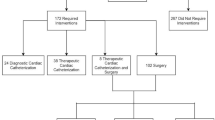Abstract
Background
There are many challenges facing Syrian refugee children with heart disease. In this report, we present the spectrum, management, and outcome of heart disease in Syrian refugee children over six-year period, highlighting challenges in management and availability of funding.
Methods
Data on Syrian refugee children with heart disease diagnosed between 2012 and 2017 were collected. Patients were followed until January 2019. Data reported included age, diagnosis, recommended treatment, types of procedures done, mortality, cost, financial sources for procedures, and outcome.
Results
415 Syrian refugee children were diagnosed with heart disease at our institution. Median age was 1·9 years (0·4–6·05) years. Children were either born in Syria and fled to Jordan with their families (224, 54%), or born in Jordan to refugee parents (191, 46%). Follow-up was established for 335 patients (81%). Of 196 patients needing surgery, 130 (72%) underwent Surgery, and of 97 patients needing interventional catheterization, 95 underwent the procedure. Waiting time was 222(± 272) days for surgery and 67(± 75) days for catheterizations. Overall mortality was 17% (56 patients), of which 28 died while waiting for surgery. Cost of surgical and interventional catheterization procedures was $7820 (± $4790) and $2920 (± $2140), respectively. Funding was obtained mainly from non-government organizations, private donors, and United Nations fund.
Conclusion
Despite local and international efforts to manage Syrian refugee children with heart disease, there is significant shortage in providing treatment resulting in delays and mortality. More organized efforts are needed to help with this ongoing crisis.

Similar content being viewed by others
References
UNHCR: Syria Regional Refugee Response; July 30, 2014. https://data.unhcr.org/syrianrefugees/regional.php. Accessed 11 Oct 2019
Krafft C, Sieverding M, Keo C, Salemi C (2018) Syrian Refugees in Jordan: Demographics, Livelihood, Education, and Health, working paper number 1184. Economic Research Forum 2018. https://erf.org.eg/publications/syrian-refugees-in-jordan-demographics-livelihoods-education-and-health. Accessed 24 Oct 2019
Murshidi MM (2016) Syrian refugees constitute 20% of Jordan's population. Am J Pub Health 106(5):e18
Dator W, Abunab H, Dao-ayen N (2018) Health challenges and access to health care among Syrian refugees in Jordan: a review. East Mediterr Health J 24(7):680–686
Doocy S, Lyles E, Akh-Zaheya L, Burton A, Weiss W (2016) Health services access and utilization among Syrian refugees in Jordan. Int J Equity Health 15(1):108
Abbas M, Jerkins R, Higgins E (2018) Assessment of Syrian Refugee children in host communities in Jordan. UNICEF Jordan Social Policy Section. https://www.unicef.org/jordan/Assessment_Syrians_in_Jordan_host_communities2018_online.pdf. Accessed 19 Oct 2019
Al-Ammouri I, Ayoub F (2016) Heart disease in Syrian refugee children: experience at Jordan University Hospital. Ann Glob Health 82:300–306
Al-Rousan T, Schwabkey Z, Jiramanus L, Nelson BD (2018) Health needs and priorities of Syrian refugees in camps and urban settings in Jordan: perspectives of refugees and health care providers. East Mediterr Health J 24:243–253
Kraft K, Smith J (2018) Between international donors and local faith communities: Intermediaries in humanitarian assistance to Syrian refugees in Jordan and Lebanon. Disasters 43:24–45
Sieverding M, Krafft C, Berri N (2018) How are families changing in Jordan? New evidence on marriage and fertility trends among Jordanians and Syrian Refugees. Economic Research Forum. Policy Brief No. 35. https://erf.org.eg/publications/how-are-families-changing-in-jordan-new-evidence-on-marriage-and-fertility-trends-among-jordanians-and-syrian-refugees. Accessed 24 Oct 2019
Online Source: https://www.independent.co.uk/news/world/middle-east/birth-rate-soars-in-jordan-refugee-camp-as-husbands-discourage-wives-from-using-contraception-a6928241.html. Accessed 19 Oct 2019.
Birth Rate, Crude (per 1,000 People). Data. World Bank. https://data.worldbank.org/indicator/SP.DYN.CBRT.IN. Accessed 19 Oct 2019
Alenezi A, Albawardi N, Ali A, Househ M, El-Metwally A (2015) The epidemiology of congenital heart diseases in Saudi Arabia: a systematic review. J Pub Health Epidemiol 7:232–240
Bitar FF, Baltaji N, Dbaibo G (1999) Abed el-Jawad M, Yunis KA, Obeid M, Congenital heart disease at a tertiary care center in Lebanon. Middle East J Anaesthesiol 15:159–164
Zaqout M, Aslem ES, Oweida FS, De Wolf D (2014) Prevalence of congenital heart disease among Palestinian children born in the Gaza Strip. Cardiol Young 24:905–909
Iyad A-A, Fares A, Laila T (2017) Incidence of congenital heart disease in jordanian children born at jordan university hospital: a seven-year retrospective study. Jordan Med J 51:109–117
Al-Mesned A, Al Akhfash AA, Sayed M (2012) Incidence of severe congenital heart disease at the province of Al-Qassim, Saudi Arabia. Congenit Heart Dis 7:277–282
Cardarelli M, Vaikunth S, Mills K et al (2018) Cost-effectiveness of humanitarian pediatric cardiac surgery programs in low- and middle-income countries. JAMA Netw Open 1:e184707
Novick WM, Stidham GL, Karl TR et al (2008) Paediatric cardiac assistance in developing and transitional countries: the impact of a fourteen year effort. Cardiol Young 18:316–323
Bode-Thomas F (2012) Challenges in the management of congenital heart disease in developing countries. Congenital heart disease—selected aspects. https://cdn.intechweb.org/pdfs/26663.pdf. Accessed 17 Oct 2019
Mocumbi AO, Lameira E, Yaksh A, Ferreira MB, Sidi D (2011) Challenges on the management of congenital heart disease in developing countries. Int J Cardiol 148:285e8
Jenkins KJ, Castaneda AR, Cherian KM et al (2014) Reducing mortality and infections after congenital heart surgery in the developing world. Pediatrics 134(5):e1422–e1430
Funding
This research received no specific grant from any agency, commercial, or non-for-profit sectors.
Author information
Authors and Affiliations
Corresponding author
Ethics declarations
Conflict of interest
The authors declare that there is no financial or personal conflict of interest associated with this work.
Ethical Approval
The authors assert that all procedures contributing to this work comply with the global and ethical standards and guidelines. This work was approved by the institutional review board at the Jordan university hospital and the University of Jordan. The corresponding author confirms that he has full access to all the data in the study and has final responsibility for the decision to submit for publication.
Additional information
Publisher's Note
Springer Nature remains neutral with regard to jurisdictional claims in published maps and institutional affiliations.
Rights and permissions
About this article
Cite this article
AL-Ammouri, I., Daher, A., Tutunji, L. et al. Outcome of Heart Disease in Syrian Refugee Children: Insights into Crisis. Pediatr Cardiol 41, 877–884 (2020). https://doi.org/10.1007/s00246-020-02325-y
Received:
Accepted:
Published:
Issue Date:
DOI: https://doi.org/10.1007/s00246-020-02325-y



